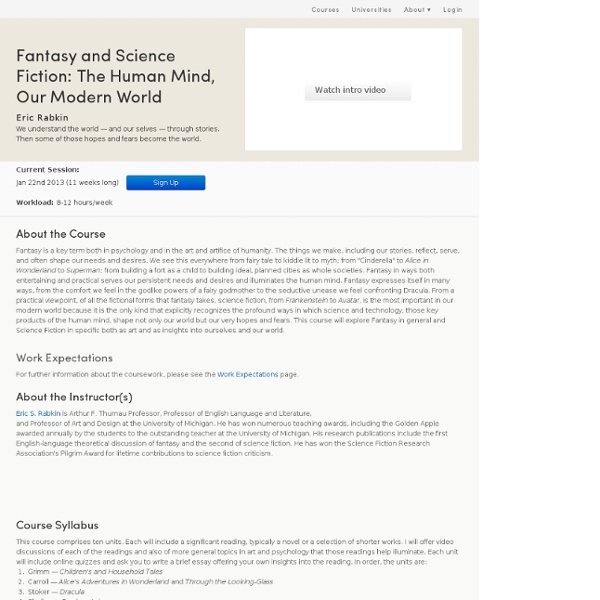



Subject materials Greek and Roman Mythology About the Course Myths are traditional stories that have endured over a long time. Some of them have to do with events of great importance, such as the founding of a nation. Course Syllabus Week 1: Homer, epic poetry, and Trojan legends Week 2: Heroes and suffering Week 3: This World and other ones Week 4: Identity and signs Week 5: Gods and humans Week 6: Religion and ritual Week 7: Justice Week 8: Unstable selves Week 9: Writing myth in history Week 10: From myths to mythology Recommended Background No special background is needed other than the willingness and ability to synthesize complex texts and theoretical material. In-course Textbooks As a student enrolled in this course, you will have free access to selected chapters and content for the duration of the course. Suggested Readings We will be covering the following in class: I strongly recommend purchasing or borrowing from a library the English translations mentioned in the welcome email and listed below. Greek Tragedies, Vol.
Listening to World Music About the Course With the click of a mouse, now more than ever we are able to access sounds made by people from all around the world. And yet, most of us don't listen to the wide diversity of music available to us, probably because it sounds so strange. Course Syllabus Week One: Introductions with an overview of recording technology history and ties to world music and cultures; vocabulary for talking about world music and global cultural encounters, and a case study of “Chant,” the 1990s Gregorian chant recording that crossed over into the popular music market.Week Two: Graceland, Paul Simon's "collaborative" album. Recommended Background Though it may be useful, you are not required to have any music theoretical knowledge to take the class. In-course Textbooks As a student enrolled in this course, you will have free access to selected chapters and content for the duration of the course. Suggested Readings Course Format Will I get a Statement of Accomplishment after completing this class?
14 Herramientas para crear libros digitales con total facilidad El uso cada vez más intenso de smartphones, tablets y lectores de eBooks ha hecho que muchos escritores o aficionados a la escritura comenzaran a editar sus libros en los formatos compatibles con estos dispositivos. Las herramientas de edición disponibles en la actualidad hacen que crear libros electrónicos o eBooks sea una tarea bastante sencilla así como también apasionante, que incluso puede reportar algunos dinerillos. En este post he compilado 14 programas para crear libros digitales en pocos pasos, con calidad y disfrutando de una experiencia única. Algunas de ellas también permite hacer libros interactivos que luego podes compartir con los más pequeño del hogar o en tus tareas de enseñanza. Te invito a que leas el artículo, pero antes echale una mirada a estos interesantes posts: 1. Es una aplicación para crear libros interactivos rápidamente así como tutoriales, presentaciones y todo tipo de documentos arrastrando y soltando. 2. 7Write 3. iBooks Author 4. 5. 6. 7. 8. 9. 10. eCub 11.
Art History The Art History discipline is designed to develop visual arts literacy, as well as critical and interpretive thinking skills. As an Art History Major, you will receive a solid grounding in the history of western art as well as the art of certain non-western cultures. The major consists of twelve courses: four mandatory “core program” courses and eight electives. The core program will introduce the principal terminology, methods, and questions that comprise the study of art history and will prepare you to discuss and understand the major issues of art history and the central debates of art historical criticism. Your first course, ARTH101: Art Appreciation and Techniques, will present you with an overview of the language, themes, and techniques most frequently used in art and its study as well as the tools you need to approach visual art from an art historical perspective. In order to complete the major, you will need to take three 400-level electives.
Introduction to Philosophy This course will introduce you to some of the main areas of research in contemporary philosophy. Each module a different philosopher will talk you through some of the most important questions and issues in their area of expertise. We’ll begin by trying to understand what philosophy is – what are its characteristic aims and methods, and how does it differ from other subjects? Then we’ll spend the rest of the course gaining an introductory overview of several different areas of philosophy.
ARTH208: Modern Art Purpose of Course showclose In this course, you will study the various artistic movements that comprise 19th- and 20th-century modern art. You will examine several dozen artists, all of whom helped define their respective artistic styles and eras through their innovative approaches to representation, artistic space, and the role of the artist in society. This course will begin with a brief review of the artists and movements that immediately preceded French Impressionism and will then take an in-depth look at the key artists and characteristics of Impressionism, widely considered the first “modern” art movement. As an example, you will be able to look at Pablo Picasso’s Les Demoiselles d’ Avignon and explain why this can be considered the first Cubist artwork, and what makes it one of the greatest achievements in modern art. Course Information showclose Welcome to ARTH208, Modern Art. Learning Outcomes showclose Course Requirements showclose In order to take this course, you must: All Units